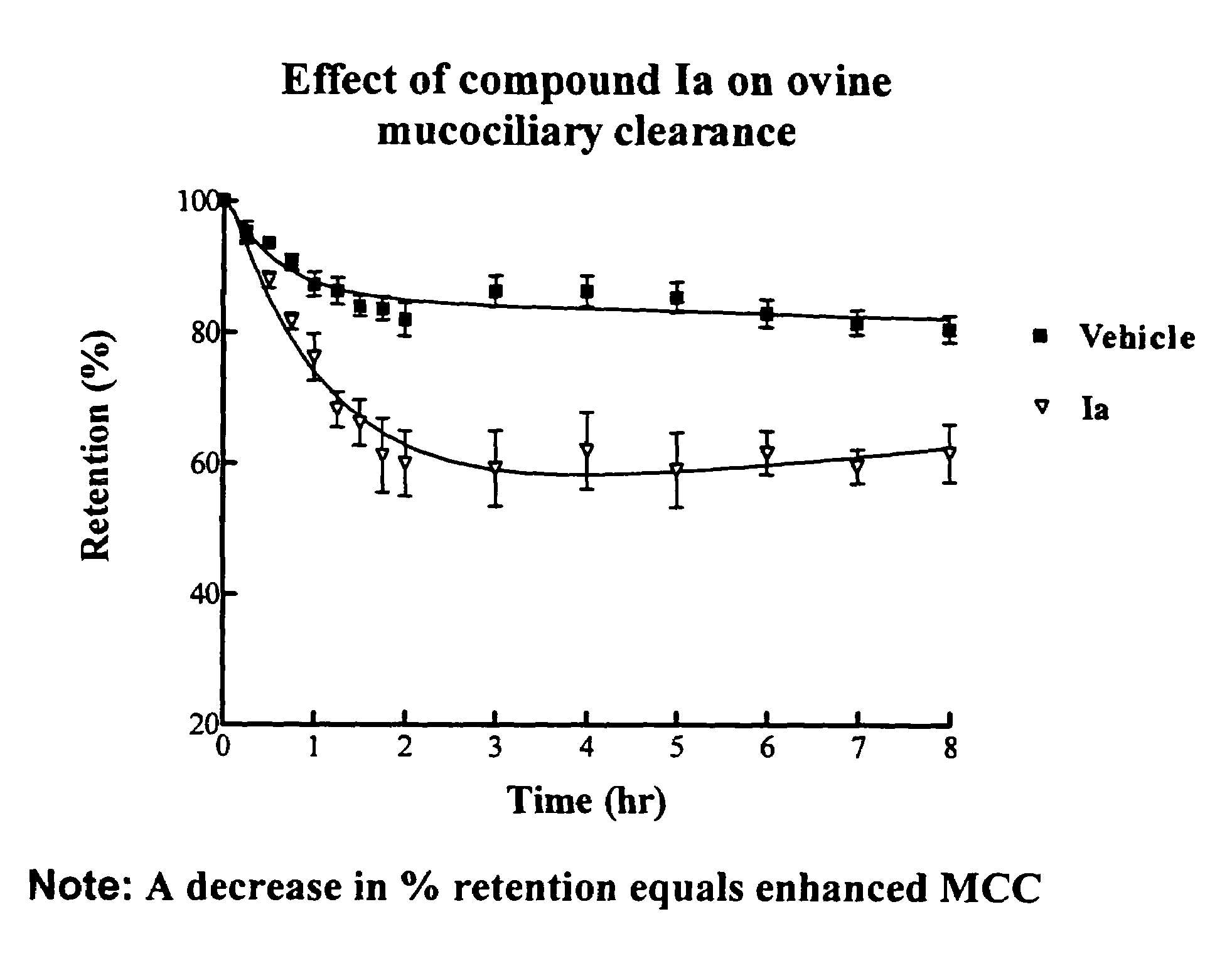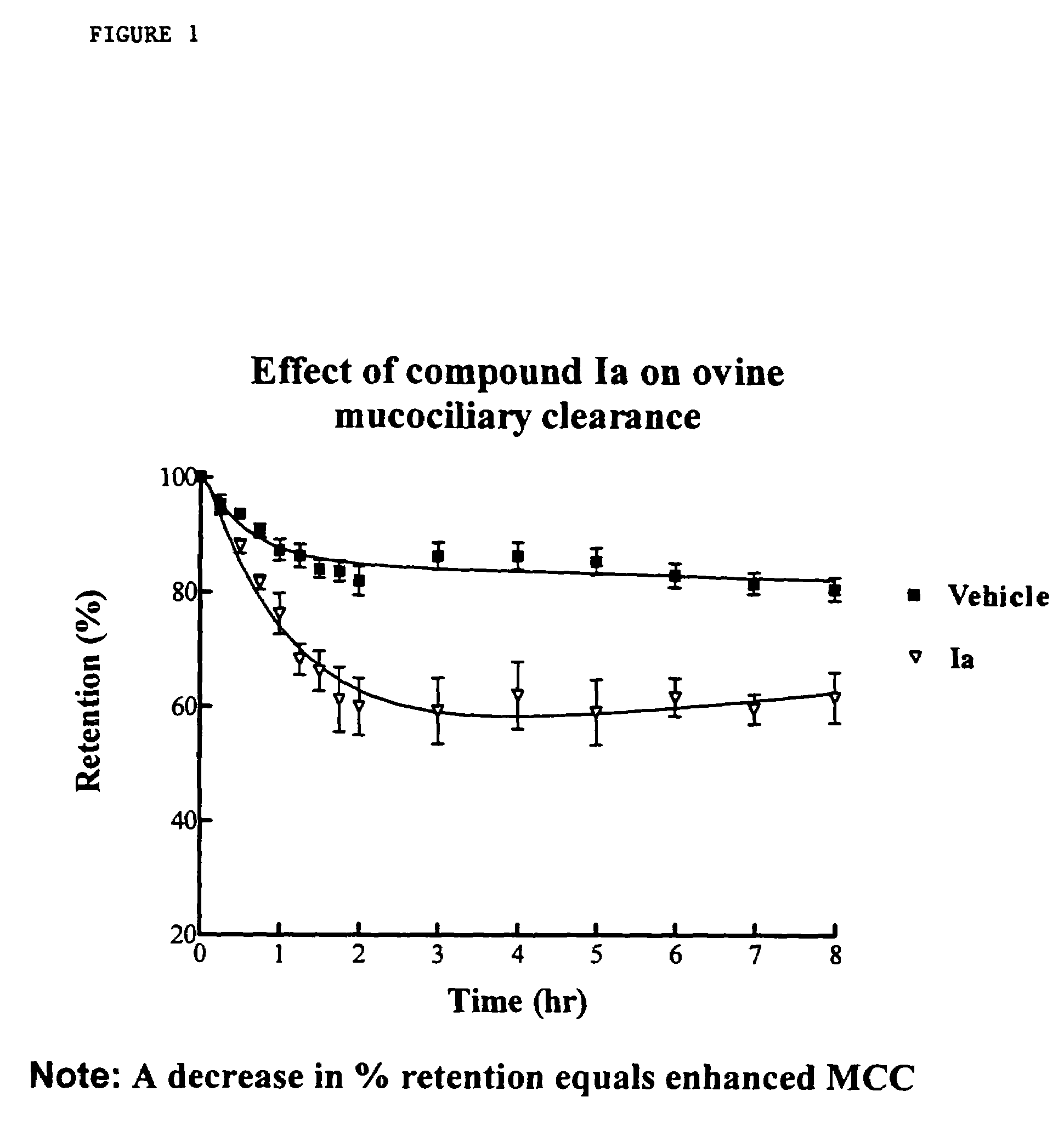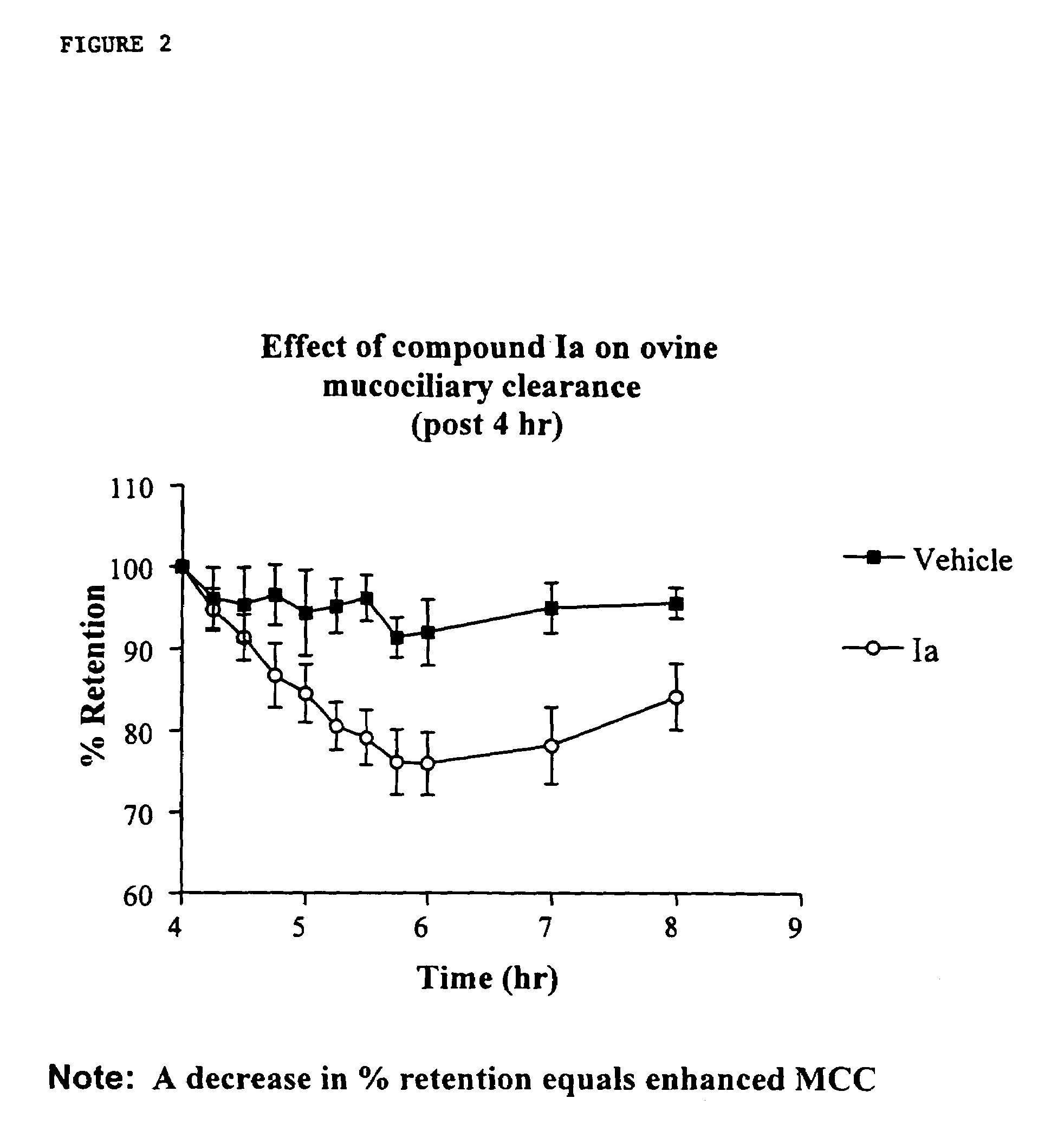Sodium channel blockers
a technology of sodium channel blocker and sulfate, which is applied in the direction of drug compositions, extracellular fluid disorders, immunological disorders, etc., can solve the problems of inability to clear mucus from airway surfaces, inability to clear mucus reflects an imbalance between the amount of liquid, and the inability to clear mucus, etc., to achieve less reversible, less reversible, and more potent
- Summary
- Abstract
- Description
- Claims
- Application Information
AI Technical Summary
Benefits of technology
Problems solved by technology
Method used
Image
Examples
example 1
4-(4-Carboxymethylphenyl)butylamidino-3,5-diamino-6-chloropyrazinecarboxamide hydrochloride (9)
[0245]
Methanesulfonic acid 4-(4-carboxymethylphenyl)butyl ester (6)
[0246]Compound 6 was prepared according to the published procedure1. 1H NMR (300 MHz, CDCl3) δ 1.75 (m, 4H), 2.78 (m, 2H), 3.12 (s, 3H), 3.88 (s, 3H), 4.22 (m, 2H), 7.28 (d, 2H), 7.98 (d, 2H).
4-(4-Carboxymethylphenyl)butylazide (7). Typical procedure C
[0247]Compound 6 (6 g, 0.02 mol) was dissolved in 80 ml of dry DMF then sodium azide (1.8 g, 0.027 mol) was added. The suspension was stirred at 80° C. (oil bath) for 3 h. The solvent was then removed at reduced pressure and the residual oil was treated with CH2Cl2 (100 mL). The resulting solution was washed with water (2×100 mL), brine and dried over magnesium sulfate. The solvent was removed under reduced pressure then the residue was redissolved in a 1:1 mixture of ethyl acetate / hexanes (200 mL) and passed through a pad of silica gel. The solvent was removed under reduced p...
example 2
4-(4-Sulfatephenyl)butylamidino-3,5-diamino-6-chloropyrazinecarboxamide (10)
[0250]
4-(4-Sulfatephenyl)butylamidino-3,5-diamino-6-chloropyrazinecarboxamide (10)
[0251]4-(4-Hydroxyphenyl)butylamidino-3,5-diamino-6-chloropyrazinecarboxamide hydrochloride 5 (0.2 g, 0.5 mmol) was dissolved in 5 mL of dry pyridine and pyridine sulfnrtrioxide (450 mg, 2.5 mmol) was added. The reaction mixture was stirred overnight at room temperature and the precipitate that formed was isolated by filtration and washed with ethyl acetate (2×25 mL) to give crude 10 (180 mg, 39%, purity 87% by HPLC). An aliquot of the crude 10 (67 mg) was purified by flash chromatography (silica gel, 6:3:0.1 methylene chloride / methanol / concentrated ammonium hydroxide) to give 10 as a yellow solid (9.3 mg, 4% based on starting 5). 1H NMR (300 MHz, DMSO-d6) δ 1.59 (br s, 4H), 2.58 (m, 2H), 3.28 (m, 2H), 7.08 (s, 4H), 7.1–7.9 (m, 6H). ESI MS m / z=456 [C16H20ClN7O5S—H]−.
example 3
4-[4-(2,3-Dihydroxypropyloxyl)phenyl]butylamidino-3,5-dismino-6-chloropyrazinecarboxamide hydrochloride (33)
[0252]
N-Cbz4-(4-hydroxyphenyl)butylamine (29)
[0253]To vigorously stirred suspension of 4 (10.5 g, 0.043 mol) in THF (approx. 150 mL) was added sodium hydrogencarbonate (11 g, 0.13 mol) and then water until a clear solution was obtained (approx. 50 mL). The reaction mixture was cooled to 0° C. then benzyl chloroformate (10 mL, 0.07 mol) was added and the reaction was stirred overnight. The solvent was removed at reduced pressure then ethyl acetate (approx. 100 mL) was added to the residue. The organics were washed with HCl (2 M solution, 2×30 mL), water (2×50 mL), and dried over sodium sulfate. The solvent was removed and the residue was purified by column chromatography (silica gel, 1:1 ethyl acetate / hexanes) to provide 29 (10 g, 85%) as a white solid. 1H NMR (300 MHz, CDCl3) δ 1.55 (br s, 4H), 2.53 (m, 2H), 3.19 (m, 2H), 5.05 (s, 2H), 5.83 (s, 1H), 6.73 (d, 2H), 7.00 (d, 2H),...
PUM
 Login to View More
Login to View More Abstract
Description
Claims
Application Information
 Login to View More
Login to View More - R&D
- Intellectual Property
- Life Sciences
- Materials
- Tech Scout
- Unparalleled Data Quality
- Higher Quality Content
- 60% Fewer Hallucinations
Browse by: Latest US Patents, China's latest patents, Technical Efficacy Thesaurus, Application Domain, Technology Topic, Popular Technical Reports.
© 2025 PatSnap. All rights reserved.Legal|Privacy policy|Modern Slavery Act Transparency Statement|Sitemap|About US| Contact US: help@patsnap.com



